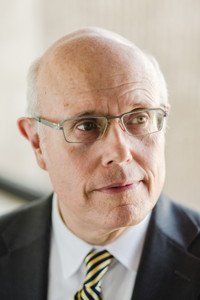The Smart Technology That Will Boost Diabetes Care
Cutting-edge technologies, as well as upgrades to existing technology tools, will improve diabetes care. Here's how.
Klonoff

David Klonoff, MD, medical director of the Diabetes Research Institute, Mills-Peninsula Medical Center in San Mateo, California, forecasted that within the next five years, people with diabetes will wear sensors that will alert them to healthy food choices when they arrive at a restaurant. The GPS-based technology, explains Klonoff, will be preprogrammed with dietary preference information based on a sound diet that is less likely to raise their blood glucose levels and leads to slightly lower mean A1c levels and complications.
Klonoff also projects widespread use of continuous glucose monitors (CGMs) which will contain alarms with personalized notifications. The alarms will signal “very low” or “very high” glucose values before they become dangerous and, as a result, reduce the incidence of admissions for hypoglycemia. Eventually, CGMs also will decrease the rates of admission for chronic complications of diabetes related to high glucose levels, such as heart attack and kidney failure.
Not only that, but CGM technology itself will become more portable, accurate, last longer, require less calibration, and yield more decision support, according to Klonoff.
“The technology will gradually push self-monitoring of blood glucose out of the marketplace for about half of patients who currently use it,” he says.
The cost of the technology also will drop. Consequently, it will be priced comparably to self-monitoring of glucose. Those factors, Klonoff says, should drive down the admission rate for severe hypoglycemia.
On the horizon
The emergence of a combination of wearable tools; like the Apple Watch, along with CGM devices together, will better monitor diabetics because of the combined biomarkers, according to Pat Keran, vice president of Innovation R&D at Optum Technology in Eden Prairie, Minnesota.
As a result, “the whole of the individual (can be evaluated), rather than just components based on these devices and what they’re reading,” Keran says.
Because individuals aren’t inclined to wear three or more devices, Keran envisions a trend in many Internet of Things (IoT) devices, equipped with multiple functions and capabilities, so a user would only need a device or two.
Also on the horizon, Klonoff expects hospitalized diabetics to be treated with a combination of hardware and software advances, which are uncommon in hospitals today. The patient will be fitted with a rapidly equilibrating CGM device and doses of insulin will be ordered by decision support software preprogrammed with the patent’s outpatient total daily insulin dose, insulin sensitivity factor, and carbohydrate-to-insulin ratio, he explains. This process will culminate in tighter mean glycemic control with less hypoglycemia, which will translate into lower costs than current diabetes management yields, as well as reduced length of hospitalization.
On top of that, the global needle-free diabetic care market, for example, is expected to grow at a CAGR of 7.5% during the forecast period 2017 to 2023.
Will the new technologies go mainstream? It will hinge on factors like the experience level of those managing care, according to Athena Tsimikas, MD, an endocrinologist at Scripps Whittier Diabetes Institute in La Jolla, California.
“Is it a primary care physician? An advanced practice provider working with a physician? (members of) an endocrinology practice? All those things play a role in how to determine what you’re going to do with these technologies, which are and will continue to be quite sophisticated,” Tsimikas says.
Chuck Green has covered healthcare for more than 10 years.
In the Scope of Virtual Health and the Future of “Website” Manner, Per Ateev Mehrotra
August 10th 2023Briana Contreras, an editor of Managed Healthcare Executive, had the pleasure of catching up with MHE Editorial Advisory Board Member, Ateev Mehrotra, MD, MPH, who is a professor of healthcare policy at Harvard Medical School and an Associate Professor of Medicine and Hospitalist at Beth Israel Deaconess Medical Center.
Listen